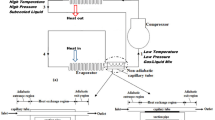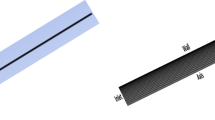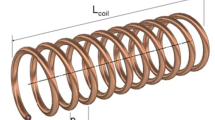Abstract
Small vapor compression refrigeration systems incorporate a non-adiabatic capillary tube called a capillary tube-suction line heat exchanger (SLHX) in order to improve performance. The thermodynamic properties of the refrigerant in the capillary tube and suction pipe are influenced by associated phenomena. This study compares various relevant models. Based on the comparison recommended correlations were selected and the simulation results show that the friction factor model has the most dominant.


















Similar content being viewed by others
Abbreviations
- A :
-
Area, m2
- C :
-
Specific heat, J/kgK
- D :
-
Diameter, m
- Fr :
-
Froude number
- f :
-
Friction factor
- G :
-
Mass flux, kg/m2s
- g :
-
Gravity acceleration, m/s2
- h :
-
Heat transfer coefficient, W/m2K
- I :
-
Specific enthalpy, kJ/kg
- i :
-
Section number
- k :
-
Thermal conductivity, W/mK
- l :
-
Lackme constant
- L :
-
Length, m
- m :
-
Mass, kg
- \( \dot{m} \) :
-
Mass flow rate, kg/s
- Nu :
-
Nusselt number
- Pr :
-
Prandtl number
- P :
-
Pressure, kPa
- \( \dot{Q} \) :
-
Heat transfer rate, kW
- Re :
-
Reynolds number
- T :
-
Temperature, K
- U :
-
Overall heat transfer coefficient, W/m2K
- V :
-
Velocity, m/s
- v :
-
Specific volume, m3/kg
- W :
-
Work rate, kW
- We :
-
Weber number
- w :
-
Width of solder joint, m
- x :
-
Vapor quality
- y :
-
Meta-stable mass fraction
- z :
-
Section length, m
- δ :
-
Soldered joint thickness, m
- ɛ :
-
Wall roughness, mm
- θ :
-
Inclination angle, deg
- μ :
-
Viscosity, Ns/m2ν
- π :
-
Pi parameter
- ρ :
-
Density, kg/m3
- σ :
-
Surface tension, N/m
- τ :
-
Shear stress, N/m2
- ϕ 2 :
-
Frictional two-phase multiplier
- Cond :
-
Condenser
- c :
-
Capillary tube
- eva :
-
Evaporator
- exp :
-
Experimental data
- hx :
-
Heat exchanger
- i :
-
Section symbol
- in :
-
Inlet
- l :
-
Liquid
- lo :
-
Liquid only
- o :
-
Outside
- out :
-
Outlet
- ref :
-
Refrigerant
- s :
-
Suction line
- sc :
-
Subcooled
- sl :
-
Superheated liquid
- sat :
-
Saturation
- SLHX :
-
Suction line heat exchanger
- sp :
-
Single-phase
- sub :
-
Subcooling
- sup :
-
Superheating
- tp :
-
Two-phase
- v :
-
Vapor
- vo :
-
Vapor only
- w :
-
Wall
References
Koizumi H, Yokoyama K (1980) Characteristics of refrigerant flow in capillary tube. ASHRAE Trans 86:19–27
Chen ZH, Li RY, Lin S, Chen ZY (1990) A correlation for meta-stable flow of refrigerant 12 through capillary tubes. ASHRAE Trans 96:550–554
Dirik E, Inan C, Tanes MY (1994) Numerical and experimental studies on adiabatic and non-adiabatic capillary tubes with R-134a. International refrigeration conference at Purdue, Purdue University. West Lafayette, Indiana, USA
Peixoto RA, Bullard CW (1994) A simulation and design model for capillary tube-suction line heat exchanger. Internal refrigeration conference at Purdue University. West Lafayette, Indiana, USA
Bittle RR, Wolf DA, Pate MB (1998) A generalized performance prediction method for adiabatic capillary tubes. HVAC&R Res 4:27–44
Mezavila MM, Melo C (1996) CAPHEAT: an homogeneous model to simulate flow through non-adiabatic capillary tubes. International refrigeration conference at Purdue. West Lafayette, Indiana, USA
Xu B, Bansal PK (2002) Non-adiabatic capillary tube flow: a homogeneous model and process description. Appl Therm Eng 22:1801–1819
Garcia-Valladares O (2002) Numerical simulation of non-adiabatic capillary tubes considering metastable region, part I: mathematical formulation and numerical model. Int J Refrig 30:642–653
Sarker D, Kim L, Son K, Jeong JH (2010) An evaluation of constituent correlations for predicting refrigerant characteristics in adiabatic capillary tubes. Int J Air-Cond Refrig (in press)
Khan MK, Kumar R, Sahoo PK (2008) Experimental and numerical investigation of the flow of R-134a through lateral type diabatic capillary tube. HVAC&R Res 14(6):871–904
Colebrook CF (1939) Turbulent flow in pipes with particular reference to the transition between the smooth and rough pipe laws. J Inst Civil Eng Lond 11:133–156
Churchill SW (1977) Frictional equation spans all fluid flow regimes. Chem Eng 84:91–92
Bittle RR, Pate MB (1996) A theoretical model for predicting adiabatic capillary tube performance with alternative refrigerants. ASHRAE Trans 102:52–64
McAdams WH, Wood WK, Bryan RL (1942) Vaporization inside horizontal tubes benzene-oil mixtures. J Heat Transf 64:193–200
Cicchitti A, Lombardi M, Silverstri G, Soldaini R, Zavattarelli (1960) Two-phase cooling experiments-pressure drop, heat transfer and burnout measurements. Energia Nucl 7:407–425
Dukler AE, Wicks M, Cleveland RG (1964) Pressure drop and hold-up in two-phase flow. Part A-A comparison of existing correlation, part B-An approach through similarity analysis. AIChE J 10:38–51
Lin S, Kwok CCK, Li RY (1991) Local frictional pressure drop during vaporization of R-12 through capillary tubes. Int J Multiph Flow 17:95–102
Lockhart RW, Martinelli RC (1949) Proposed correlation of data for isothermal two-phase two-component flow in pipes. Chem Eng Prog 45(1):39–48
Friedel L (1979) Improved friction pressure drop correlation for horizontal and vertical two-phase pipe flow. European two-phase group meeting, Paper E2, Ispra, Italy
Whalley PB (1980) Multiphase flow and pressure drop. In: Hewitt GF (ed) Heat exchanger design handbook, vol 2. Hemisphere, Washington DC, pp 2.3.3–2.3.11
Dittus FW, Boelter LMK (1930) Heat transfer in automobile radiators of tubular type. Univ Calif, Berkeley, Publ. Eng 2(13):443–461
Gnielinski V (1976) New equations for heat transfer in turbulent pipe and channel flow. Int Chem Eng 16:359–368
Wu PY, Little WA (1984) Measuring of the heat transfer characteristics of gas flow in fine channel heat exchangers for micro miniature refrigerators. Cryogenics 24:415–420
Lackme C (1979) Incompleteness of the flashing of supersaturated liquid and sonic ejection of the produced phases. Int J Multiph Flow 5:131–141
Feburie V, Giot M, Granger S, Seynhaeve JM (1993) A model for choked flow through cracks with inlet subcooling. In J Multiph Flow 19:541–562
Li RY, Lin S, Chen ZH (1990) Numerical modeling of thermodynamic non-equilibrium flow of refrigerant through capillary tubes. ASHRAE Trans 96:542–549
Melo C, Ferreira RTS, Neto CB, Goncalves JM, Mezavila MM (1999) An experimental analysis of adiabatic capillary tubes. Appl Therm Eng 19:669–684
Mendoca KC, Melo RTS, Pereira RH (1998) Experimental study on lateral capillary tube-suction line heat exchangers. International refrigeration conference at Purdue. West Lafayette, Indiana, USA
Wolf DA, Pate MB (2002) Performance of a suction-line/capillary-tube heat exchanger with alternative refrigerants. ASHRAE research project RP-948, Final report
Wolf DA, Bittle RR, Pate MB (1995) Adiabatic capillary-tube performance with alternative refrigerants. ASHRAE research project RP-762, Final report
Acknowledgment
This work was supported by the National Research Foundation of Korea (NRF) grant funded by the Korea government (MEST) (No. 2009-0072026).
Author information
Authors and Affiliations
Corresponding author
Rights and permissions
About this article
Cite this article
Kim, LS., Son, Kd., Sarker, D. et al. An assessment of models for predicting refrigerant characteristics in adiabatic and non-adiabatic capillary tubes. Heat Mass Transfer 47, 163–180 (2011). https://doi.org/10.1007/s00231-010-0697-0
Received:
Accepted:
Published:
Issue Date:
DOI: https://doi.org/10.1007/s00231-010-0697-0




